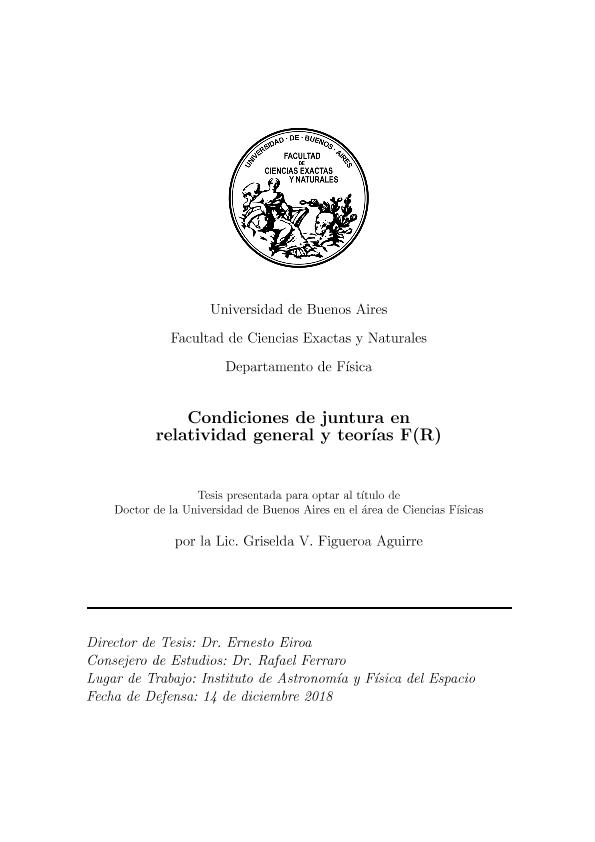Tesis doctoral
Las condiciones de juntura permiten la unión de dos soluciones de las ecuaciones de la gravedad a través de una hiper-superficie y son de gran utilidad en varios contextos. El empalme de las soluciones puede ser suave o a través de una cáscara de espesor infinitesimal en la hiper-superficie de juntura.Las teorías de gravedad modificada aparecen como posibles alternativas con el fin de intentar resolver distintos problemas que surgen dentro del marco de la relatividad general. Un caso de interés son las llamadas teorías F(R), en las cuales la densidad lagrangiana es una función arbitraria del escalar de curvatura. En ellas, las condiciones de juntura difieren de las correspondientes a la relatividad general (formalismo de Darmois-Israel).En la presente Tesis se construyen agujeros de gusano, burbujas y cáscaras delgadas alrededor de agujeros negros, en todos los casos uniendo dos variedades diferenciales con simetría esférica, en el contexto de las teorías F(R) y utilizando las condiciones de juntura correspondientes.En los agujeros de gusano, la garganta corresponde a la superficie de juntura, en la cual hay presente una capa delgada de materia.Las burbujas consisten en una cáscara infinitesimal que rodea una región de vacío. Se estudian también cáscaras delgadas de materia por fuera del horizonte de eventos de agujeros negros. En todos los casos se buscan las soluciones estáticas posibles y se analiza su estabilidad ante perturbaciones que conservan la simetría. Se encuentra que existen soluciones estables para determinados valores de los parámetros del modelo.En particular, en gravedad F(R) cuadrática es posible la presencia de una capa doble en la superficie de juntura. En este caso, se obtuvo el primer ejemplo explícito de burbujas de capa doble pura. Finalmente se discuten las diferencias con respecto a configuraciones análogas en la relatividad general. The junction conditions allow the union of two solutions of the equations of gravity through a hypersurface and they are very useful in many different contexts. The union of the solutions can be smooth or through a shell of infinitesimal thickness at the junction hypersurface. Modified gravity theories appear as possible alternatives in order to try to solve different problems that arise within the framework of General Relativity. A case of interest are the so-called F(R) theories, in which the Lagrangian density is an arbitrary function of the curvature scalar. In them, the junction conditions differ from those in General Relativity (Darmois-Israel formalism). In the present Thesis, wormholes, bubbles, and thin shells around black holes are constructed by joining two spherically symmetric manifolds within the framework of F(R) theories and using the corresponding junction conditions. In wormholes, the throat corresponds to the junction surface, where a thin shell of matter is present. The bubbles consist of an infinitesimal layer surrounding a vacuum region. Thin shells of matter outside the event horizon of black holes are also studied. In all of these cases, static solutions are sought, and their stability is analyzed under perturbations that preserve the symmetry. It is found that there exist stable solutions for given values of the parameters of the model. In particular, quadratic F(R) theories allow the presence of a double layer at the junction surface. In this case, the first explicit example of pure double layer bubbles is obtained. Finally, the differences with respect to analogous configurations in General Relativity are discussed.
Condiciones de juntura en relatividad general y teorías F(R)
Título:
Junction conditions in General Relativity and F(R) theories
Figueroa Aguirre, Griselda Verónica

Director:
Eiroa, Ernesto Fabian

Consejero de estudios:
Ferraro, Rafael

Fecha de publicación:
14/12/2018
Idioma:
Español
Clasificación temática:
Resumen
Archivos asociados
Licencia
Identificadores
Colecciones
Tesis(IAFE)
Tesis de INST.DE ASTRONOMIA Y FISICA DEL ESPACIO(I)
Tesis de INST.DE ASTRONOMIA Y FISICA DEL ESPACIO(I)
Citación
Figueroa Aguirre, Griselda Verónica; Eiroa, Ernesto Fabian; Ferraro, Rafael; Condiciones de juntura en relatividad general y teorías F(R); 14-12-2018
Compartir



